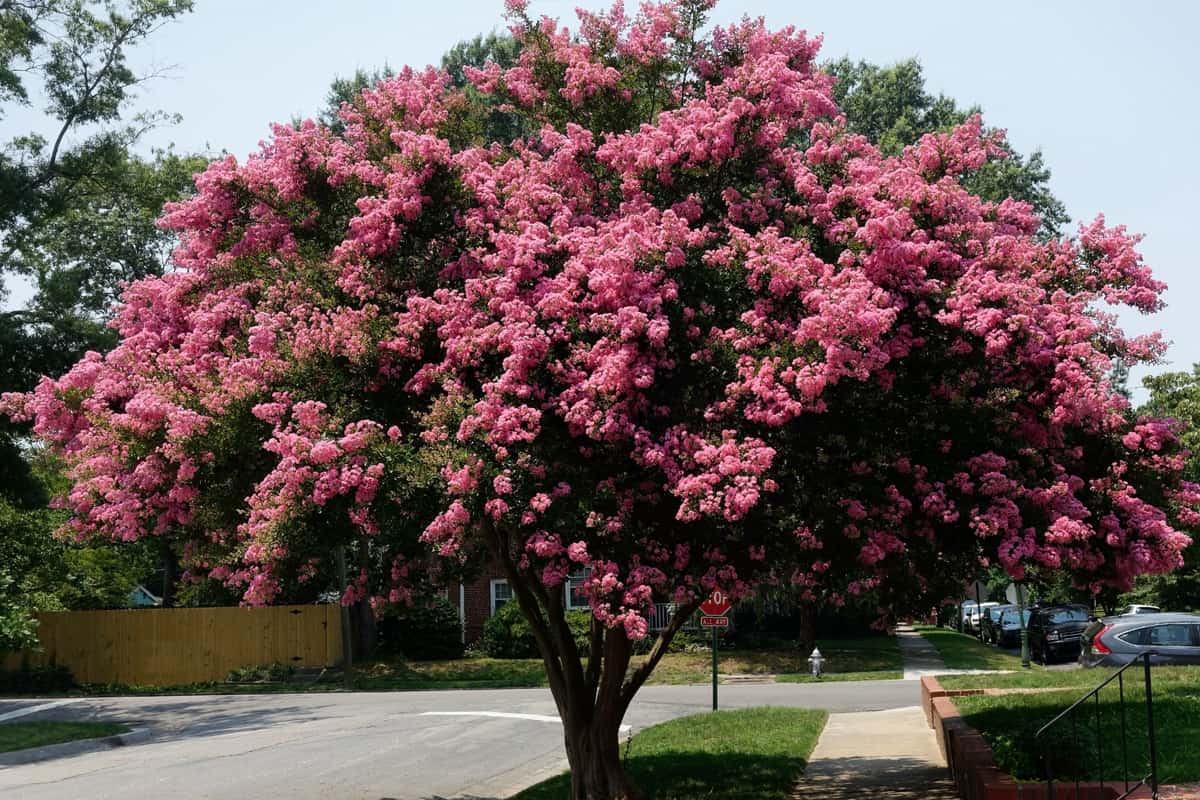Are you wondering about the difference in trimming the crepe myrtle bush and tree? You are on the right page. We've checked with the experts to help you determine the correct way to shape them. Here is the answer!
Shaping a crepe myrtle bush and tree has no significant distinction. The frequency and tools used will have a few deviations. Nonetheless, using the proper tools, prune them at the ideal times to remove dead or disease parts. It can be after the first flowering period or as needed.
In this post, we have a detailed discussion on crepe myrtle. We will also explore other related topics, such as its propagation, primary care, varieties, and uses. So, please keep on reading to learn more.

What Is A Crepe Myrtle?
Crepe myrtle (Lagerstroemia spp.), also spelled as crape myrtle, is generally a deciduous shrub and tree with at least 50 species. Meanwhile, some variants are evergreen and semi-deciduous.

Although it originated in Asia, Australia, and Oceania, it is also widespread in South America these days. Hence, people also call it the "Lilac of the South." Regardless of variety, they are a popular choice for residential and commercial areas because of the bold aesthetics they bring.
Basic Care For Crepe Myrtle
Keep in mind these essential aspects while taking care of crepe myrtle plants. With a moderate growth rate, they increase up to 3 feet annually. Also, they require minimal requirements because they thrive in tropical climates.
- Sowing Season: fall and spring
- Maturation Period: 5 to 10 years
- Average Lifespan: over 50 years
- Soil Condition: well-draining; flexible pH; clay, sand, or loam
- Light Exposure: full sun to partial shade
- USDA Hardiness Zones: 6 to 9
How Do You Identify A Crepe Myrtle?
Appreciate its bright flowers in white, red, pink, or lavender. Arranged in branching clusters, they will bloom from early summer until fall. The wrinkled petals are comparable to crepe paper.
Along with the lovely blossom, a few noticeable features are the inverted-vase shape and brown-gray bark.
Green leaves have an alternating pattern and oval form. Likewise, they turn red, orange, and yellow during fall. When divided, you can see red edges.
What Is The Difference Between Crepe Myrtle Bush and Tree?
You can grow a crepe myrtle in two ways: bush and tree. The primary difference lies in their dimension. The bush remains below 11 feet in height, whereas the tree can reach 20 to 30 feet at maturity.
Another important aspect is the number of stems or trunks. A multi-stemmed bush expands from the base while the single-trunk maintains an upright position before branching out.
How to Prune Crape Myrtles?

Pruning is vital to all plant maintenance, but you should not overdo it. Thus, follow this guide.
Single-trunk Crepe Myrtles
While it is young, select a shoot you want to train into your trunk. It should be a strong stem that grows vertically straight. Then, cut out the remaining shoots. Using a flexible strip, stake the trunk to prevent any movements and keep it anchored to the soil.
Next, remove the lower portion of branches from the stem but ensure that you will only expose a third or half of the tree's overall height. Repeat this approach as you notice the emerging branches every winter month.
Afterward, narrow back to the strongest stems with hand pruning shears or extendable pruners if the portion is beyond your reach. Ultimately, shape the crown by removing the unruly branches for tamed growth across all directions. Maintain the interior arms as thin as needed. It will provide sufficient light penetration.
Click here to see this extendable pruning stick on Amazon.
Multi-stemmed Crepe Myrtles
In contrast, keep at least three or five tough stems to achieve a bushy structure. They must be dispersed and grow slightly away from each other.
Chop the lowest 1/3 of each main stem using hand pruners. Then, create an open canopy by removing crossed branches. As it spreads, continue to take out the lower sections and emerging suckers from the base of the crepe myrtles.
Click here to see these hand pruning shears on Amazon.
To discover the causes of spent flowers, view this guide: Crepe Myrtle Flowers Are Falling Off - What's Wrong?
What Are The Best Varieties Of Crepe Myrtle?
The best variety will depend on where you are and what size and appearance you prefer.
The queen crepe myrtle (Lagerstroemia speciosa) is the largest species conducive to big and warm areas. The most popular one is the common crepe myrtle (Lagerstroemia indica), whereas the smaller Japanese variant (Lagerstroemia fauriei) is a hybrid of the indica with better hardiness in cold regions.
Moreover, there are dozens of cultivars available in the market.
Cultivars
In this section, we listed the cultivars or breeds of crepe myrtle that are resistant to diseases. Choosing these breeds will save you from headaches in the future.
- Apalachee
- Basham’s Party Pink
- Caddo
- Dodd #2
- Fantasy
- Glendora White
- Hopi
- Lipan
- Miami
- Osage
- Pecos
- Regal Red
- Sarah’s Favorite
- Sioux
- Tonto
- Velma’s Royal Delight
- Wichita
- Carolina Beauty
-
Gray’s Red
- Orbin’s Adkins
- Potomac
- Raspberry Sundae
- Wonderful White
We also found other pests for this tree and how to get rid of them, so read this post to be aware: What Is Eating My Crepe Myrtle? [4 Common Pests].
How To Landscape Crepe Myrtle?

Crepe myrtle trees and shrubs can transform your landscape in several ways. But before that, remember the ideal interval for small trees is 3 to 4 feet, whereas the larger ones must be at least 10 feet.
- Stand-alone in the yard
- Formed in a row for the property border
- Street tree or along a drive or wall
- Displayed in containers
- Tree Massing
- Pollards
What Are The Uses of Crepe Myrtles?
Crepe myrtle's roots, leaves, flowers, and bark come in handy. In addition to the ornamental and shade purposes, we collected other uses of this versatile plant.
- Astringent mouthwash
- Essential oil
- Pollination
- Spice
- Textile dye
- Timber (furniture)
- Tisane
- Traditional medicine (skin problems and wounds)
What Plants Go With Crepe Myrtles?

Consider these vines and flowers to become companion plants of crepe myrtles.
- African iris
- Blanket flower
- Common thrift
- Flax lily (dwarf and variegated)
- Hibiscus
- Indian hawthorn
- Jack sprat
- Jasmine (pink and star)
- Lantana
- Mexican daisy
- Pink trumpet tree
- Sea mallow
- Snow in summer
- Sweet olive
- Violet trumpet
- White shrub rose
Final Thoughts

Pruning crepe myrtle is a straightforward process, whether it is a bush or a tree. However, do it with care. It will only take a few minutes of your time yearly. Similarly, it is an efficient way to keep it in shape and prevent troubles in the long run.
Meantime, this ornamental tree also serves various functions in your daily life. Thus, select the best cultivar depending on your location and preferences when you opt to expand your landscape.
Thanks for reading! If you enjoyed this post, explore these articles to have more insights about crape myrtle care:
5 Best Fertilizers For Crepe Myrtles



